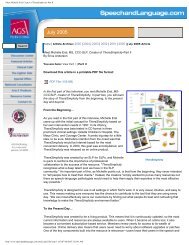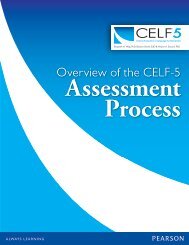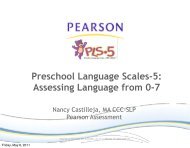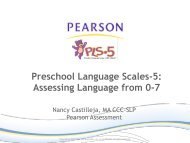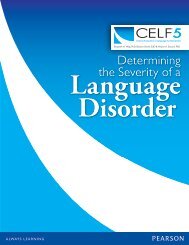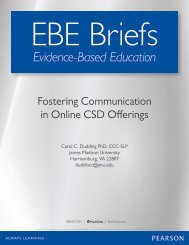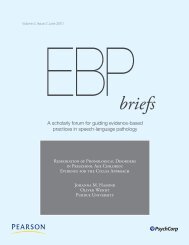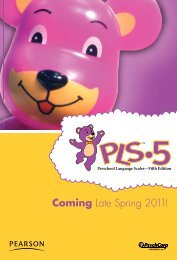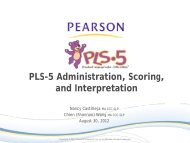Acrobat Distiller, Job 39 - Speech and Language
Acrobat Distiller, Job 39 - Speech and Language
Acrobat Distiller, Job 39 - Speech and Language
Create successful ePaper yourself
Turn your PDF publications into a flip-book with our unique Google optimized e-Paper software.
Insights from AGS Publishing Development<br />
Articulation <strong>and</strong> Phonology Are Not Normally Distributed-Who cares?<br />
You do!<br />
May 2002 Clinical Café by Tina Radichel, M.S., CCC-SLP<br />
Periodically we see a trend in calls <strong>and</strong> e-mail questions<br />
from customers. Because you are a distinguished member<br />
of the SLPForum, we'd like to supply you with a bit of<br />
continuing education that may help you <strong>and</strong> your colleagues<br />
in your day-to-day clinical practice. We would also like to<br />
offer you a FREE gift in this e-mail, so read on!<br />
Our particular insight this issue relates to the more<br />
accurate scores available from the GFTA-2 <strong>and</strong> KLPA-2<br />
results. Grab a cup of coffee <strong>and</strong> sit back for a two-minute<br />
read that will save you hours of thinking time later.<br />
Since the publication of the GFTA-2, questions have been<br />
raised about the difference between scores on the 1986<br />
edition of GFTA <strong>and</strong> the GFTA-2. The 1986 GFTA norms<br />
were percentiles extrapolated from two different databases:<br />
the National <strong>Speech</strong> <strong>and</strong> Hearing Survey (Hull, Mielke,<br />
Willeford, & Timmons, 1976) <strong>and</strong> the Khan <strong>and</strong> Lewis work<br />
of 1986. The use of two unrelated databases collected at<br />
Clinical Café by Tina Radichel, M.S., CCC-SLP<br />
two different points in time is part of the reason for score<br />
differences. However, the key reason for the difference in scores lies in how the normative scores were<br />
developed.<br />
The psychometrician who worked on the original GFTA norms applied the methods of normative score<br />
development based on a "normal" distribution of data. This method did not result in scores that appropriately<br />
represented the extremes of the distributions of articulation errors for each age. For example, according to<br />
the 1986 norms, a female who was aged 6 years 6 months <strong>and</strong> made no errors would have a percentile rank<br />
of 99. This would mean that only 1 percent of girls that age made no errors. Of course, this is not true.<br />
According to the GFTA-2 norms, the percentile rank for girls at 6-6 making no errors is appropriately listed at<br />
>65. This means that, at this age, 65 percent make one or more errors <strong>and</strong> 35 percent make no errors.<br />
<strong>Speech</strong>-language pathologists know, <strong>and</strong> research on normal articulation development tells us, that this is a<br />
more accurate representation.<br />
As stated in the GFTA-2 manual, articulation ability is not normally distributed in the general population in<br />
the same way as many other abilities. The expectation that children master all sound production by age 8<br />
makes the "normal curve" for articulation inherently skewed. Many state/district's qualification criteria<br />
for special services are based on a system of using percentiles derived from forcing articulation data into a<br />
normalized distribution scale. Forcing data in this manner is not appropriate based on articulation<br />
development.<br />
Here's another example: If a boy who is 4-6 has a percentile rank of 2 on the 1986 GFTA or on another<br />
articulation test with scores developed by forcing the data into a normalized distribution, this would equate to<br />
a st<strong>and</strong>ard score of 70. This score is two st<strong>and</strong>ard deviations (SDs) below the mean <strong>and</strong> represents a<br />
significant difference or distance from average. Alternatively, if this same boy gets a st<strong>and</strong>ard score of 70 on<br />
the GFTA-2, he would have a percentile rank of 6. This rank of 6 is equivalent to the percentile rank of 2 on<br />
a "normalized" distribution or on a test developed by those means. In either case, this child's articulation is<br />
significantly different from normal or average <strong>and</strong> is in need of remediation.
So you are now saying, "Help! Now what?"<br />
If you need to incorporate GFTA-2 non-normalized distribution results into a qualification system that is<br />
based on a normalized distribution system, here's what you do:<br />
• Determine the cut-off percentile for services in your state/district.<br />
Example:<br />
the 10th percentile.<br />
• Look at the "Percentile Rank to St<strong>and</strong>ard Score Table" in the norms section of one of your favorite<br />
tests that is based on the bell curve.<br />
Examples:<br />
PPVT-III Norms Booklet - Page 44<br />
EVT Manual - Page 172<br />
CASL Norms Book - Page 121<br />
OWLS LC/OE Manual - Page 183<br />
• According to this table based on a normalized distribution, determine the St<strong>and</strong>ard Score that<br />
equates to your district/state cut-off.<br />
Example:<br />
10th Percentile = St<strong>and</strong>ard Score of 81.<br />
• Use this St<strong>and</strong>ard Score as your qualification criteria instead of the percentile rank on the GFTA-2.<br />
Example:<br />
In a system based on normalized distribution criteria, any child who receives a St<strong>and</strong>ard<br />
Score of 81 or below on the GFTA-2 would qualify for services.<br />
Voila!<br />
As stated in this example, if your school district/state uses a specific percentile (10th), this is equivalent to a<br />
st<strong>and</strong>ard score of 81 in a normal distribution. The st<strong>and</strong>ard score of 81 represents a specific variance from<br />
average (regardless of the distribution). Because articulation is not normally distributed, using the st<strong>and</strong>ard<br />
score of 81 allows you to keep the same reference point (as different from average). The percentiles vary<br />
depending on the age of the child, but his or her reference to average does not. Keeping the metric of 81 as<br />
your cut-off means that you are serving the children who are similarly discrepant from average regardless of<br />
age.<br />
Compare your test results using this FREE booklet!<br />
Call AGS Publishing Customer Service at 1-800-328-2560 or submit the online contact form to get your<br />
complimentary GFTA-2 Supplemental/Developmental Norms Booklet (Ask for item number 11754).<br />
Using the information presented in this booklet, you can check, for example, that a male child aged 4-6<br />
should have mastered the articulation of 29 of the 77 sounds possible on the GFTA-2 (using 90% as the<br />
acquisition level cut-off). Compare the GFTA-2 test results to the developmental normative data to<br />
determine which sounds are developmentally appropriate <strong>and</strong> which are not. Then you can base your<br />
therapy strategy on this information.
Here's something else . . .<br />
AGS Publishing recently published Khan Lewis Phonological Analysis - Second Edition (KLPA-2). The<br />
KLPA-2 (item number 11820) is a norm-referenced, in-depth analysis of overall phonological process usage.<br />
It is a companion tool for the GFTA-2 articulation test. The KLPA-2 was designed to provide further<br />
diagnostic information on the 53 target words elicited by the GFTA-2 Sounds-in-Words. This tool will help<br />
you deepen your analysis of speech sound patterns.<br />
In closing, we'd like to thank you for your ongoing service to people with communication needs <strong>and</strong> we at<br />
AGS Publishing are here to support you with that effort. Assessment analysis <strong>and</strong> interpretation is an<br />
important topic for our field; if you'd like to discuss this topic further, please feel free to use the SLPForum<br />
Discussion Center as the vehicle for an ongoing discussion with your colleagues.<br />
http://www.slpforum.com/forum/cgi-bin/Ultimate.cgi<br />
Should you have questions regarding these or other AGS Publishing <strong>Speech</strong> <strong>and</strong> <strong>Language</strong> products, we<br />
welcome your phone calls at 1-800-328-2560 8-5 CST or submit the online contact form.<br />
Enjoy the spring!


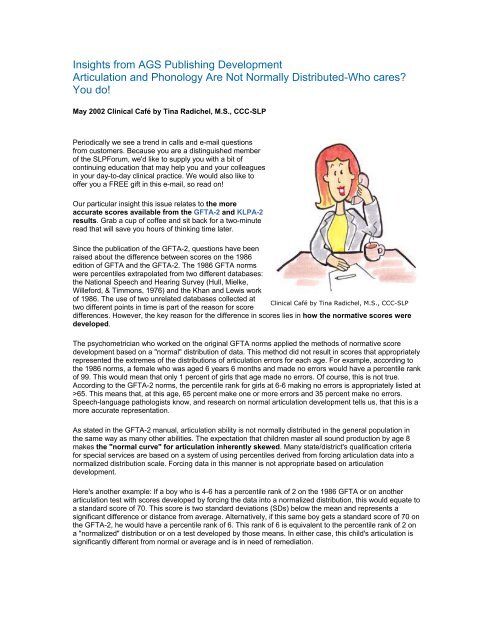
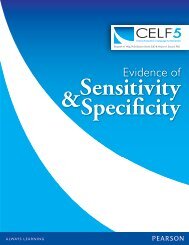
![EBP Brief V1 Issue 1 [8x10].indd - Speech and Language](https://img.yumpu.com/51068713/1/190x238/ebp-brief-v1-issue-1-8x10indd-speech-and-language.jpg?quality=85)

